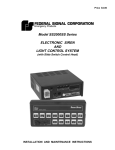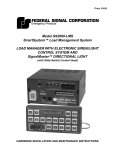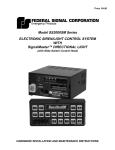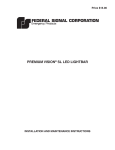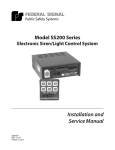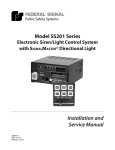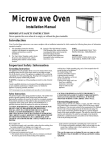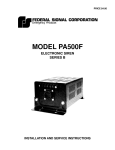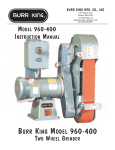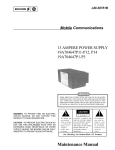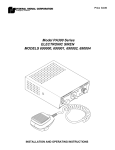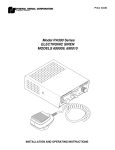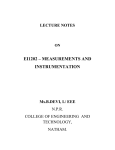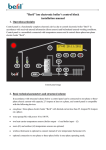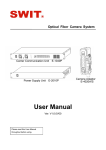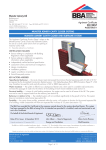Download Model SS2000-ERCSN1 ELECTRONIC SIREN with PARK
Transcript
Price $4.00 Model SS2000-ERCSN1 ELECTRONIC SIREN with PARK-SIREN DEACTIVATION INSTALLATION AND OPERATING INSTRUCTIONS LIMITED WARRANTY The Signal Division, Federal Signal Corporation (Federal), warrants each new product to be free from defects in material and workmanship, under normal use and service, for a period of two years on parts replacement and one year on labor from the date of delivery to the first user-purchaser. During this warranty period, the obligation of Federal is limited to repairing or replacing, as Federal may elect, any part or parts of such product which after examination by Federal discloses to be defective in material and/or workmanship. Federal will provide warranty for any unit which is delivered, transported prepaid, to the Federal factory or designated authorized warranty service center for examination and such examination reveals a defect in material and/or workmanship. This warranty does not cover travel expenses, the cost of specialized equipment for gaining access to the product, or labor charges for removal and re-installation of the product. Lamps, flash tubes, or batteries are not covered under warranty. This warranty does not extend to any unit which has been subjected to abuse, misuse, improper installation or which has been inadequately maintained, nor to units which have problems relating to service or modification at any facility other than the Federal factory or authorized warranty service centers. THERE ARE NO OTHER WARRANTIES, EXPRESSED OR IMPLIED, INCLUDING BUT NOT LIMITED TO, ANY IMPLIED WARRANTIES OF MERCHANTABILITY OR FITNESS FOR A PARTICULAR PURPOSE. IN NO EVENT SHALL FEDERAL BE LIABLE FOR ANY LOSS OF PROFITS OR ANY INDIRECT OR CONSEQUENTIAL DAMAGES ARISING OUT OF ANY SUCH DEFECT IN MATERIAL OR WORKMANSHIP. IMPORTANT WIRING INFORMATION WARNING The Federal SS2000-ERCSN1 is an advanced microprocessor based siren system. Unlike conventional siren systems, malfunctions and/or improper operation WILL result if proper installation procedures are not followed. Refer to the accompanying diagram and pay special attention to the "CHECK LIST" at the bottom of this page. To complete the electrical installation, refer to paragraph 3-5. CONTROL HEAD AMPLIFIER/RELAY UNIT 1 2 SIREN + BAT RELAY SWITCHED POWER TO LIGHTS 3 A B C 12 11 RELAY SWITCHED POWER TO AUXILIARY DEVICES D 10 CB1 CIRCUIT BREAKER E 9 8 6 3 7 5 2 RED + 8/10AWG (MIN.) 4 BLK AUXILIARY RELAY 50 AMP 50 AMP 1 GRN VEHICLE CHASSIS RED FUSE BLOCK 20 AMP SWITCHED IGNITION LINE CAPABLE * OF CARRYING AN ADDITIONAL 20A. - NEG * POS + VEHICLE BATTERY CHASSIS GROUND, AT FUSIBLE LINK ON FRONT FENDER. 290A4053-01 CHECK LIST 1. Is the red wire from the twelve pin connector (Pin 6) connected to a point on the fuse block that is powered in run and start positions? Use an in-line 20A fuse. YES 2. Is the black wire from the twelve pin connector (Pin 4) connected to the fusible link at the front fender between the negative (-) battery terminal and chassis ground? This is the ONLY chassis ground allowed for this wire. YES 3. Is the green wire from the twelve pin connector (Pin 5) connected to chassis ground? YES AUXILIARY RELAY/SIREN POWER: 4. Is an 8/10 AWG wire connected to the load side of the 50/100-ampere circuit breakers? Route it through the hole labeled +BAT on the amplifier/relay unit and attach it to LUG 1 on the circuit board. Use a 10 AWG wire with the 50-ampere circuit breaker. Use an 8 AWG wire with the 100-ampere circuit breaker. YES i SECTION I GENERAL DESCRIPTION Any control head which conforms to the serial interface definition in Section II, such as the GE S825 Radio Control Head, may be used. Most control heads of this type can be programmed to provide the automatic, simultaneous light and siren activation required by some laws. Momentary or push-on/push-off relay operation is also provided. The SS2000-ERCSN1’s flexibility allows variation of all of these features during control head programming. The SS2000-ERCSN1 may be installed in the trunk, under the seat, or on the dash of any vehicle with a 12 volt, NEGATIVE ground electrical system. The siren circuits are protected from failure modes by an in-line fuse that is replaceable without tools. Relay outputs are protected by individual fuses. Connection between the control head and the SS2000-ERCSN1 is via a seven-conductor cable with connectors at both ends for simple installation. 290A4053-02 Figure 1-1. Model SS2000-ERCSN1. The Federal Model SS2000-ERCSN1 (figure 1-1) is a full-featured electronic siren and light control system. State-of-the-art microprocessor technology is utilized to produce a small, compact, remotely mounted unit. When combined with a properly programmed control head, the SS2000-ERCSN1 provides a highly versatile electronic siren and light system. The SS2000-ERCSN1 can drive one or two 11-ohm impedance high power (100 Watt) or low power (58 Watt) speakers. When two speakers are used they must always be connected in parallel and in phase. The SS2000-ERCSN1 produces wail, yelp, and hi-lo siren tones, as well as an air horn sound. A horn ring transfer feature allowing horn ring control of siren tones is available. Public address (PA) and radio rebroadcast, as well as PA and radio rebroadcast volume adjustment, are provided by the control head. In addition, eight relay outputs are available for control of light bars, other auxiliary lights, and accessories. A Park-Siren Deactivator, which deactivates all tones when the car is shifted into park, is also included. Other advanced features of the SS2000-ERCSN1 include: All system functions must be controlled by a user-supplied control head, usually mounted on or near the dash of the vehicle. The SS2000-ERCSN1 communicates with the control head through a serial interface as defined in Section II. -1- • High degree of reliability and compact size through the use of CMOS microprocessor and other integrated circuits. • Simplified installation and service through use of plug-in cables and printed circuit boards. • Relay outputs are individually fused with standard automotive type fuses. SECTION II SPECIFICATIONS AND SERIAL INTERFACE DEFINITION 2-1. SPECIFICATIONS. Input Voltage ....................................................... 11VDC to 15VDC. Polarity ................................................................. Negative ground only. Operating Temperature Range ........................... -30°C to +65°C. Standby Current .................................................. Less than 1 ma. when turned off by control head. Less than .25 amperes when turned on by control head. Operating Current ............................................... (no lamps on) 9 amperes (nominal). (13.6V battery, 11 ohm load @ high power) Frequency Range ................................................. 725 to 1600Hz (nominal). Nominal Cycle Rate ............................................. Wail - 12 cycles/min. Yelp - 180 cycles/min. Hi-Lo- 60 cycles/min. Dimensions (HWD) .............................................. 2-5/16" (5.87cm) x 6-3/8" (16.2cm) x 6-1/4" (15.9cm). Net Weight ........................................................... 3-3/8 lbs. (1.534kg). Shipping Weight .................................................. 6 lbs. (2.73kg). Nominal Voltage Output ..................................... 64V peak to peak (siren tones). Audio Response .................................................... 300Hz to 3,000Hz ± 3db. Audio Power ......................................................... 45 watts (typical with 1.4 V peak to peak input). Harmonic Distortion ............................................ Less than 10% from 5 to 45 watts. Input Impedance (audio) ..................................... 4000 ohms (nominal). -2- 3. 2-2. SERIAL INTERFACE DEFINITION. This open collector output from the control head must produce a low to turn the SS2000ERCSN1 on and an open to turn it off. To turn the unit on, a relay will be activated which requires a minimum of 200ma. WARNING Property damage, serious injury, or death to you or others may result if the user-supplied control head is incompatible, unsuitable or improperly programmed. It is the USER’s responsibility to determine compatibility, suitability, and ensure proper programming of the selected control head. 4. 5. Serial Interface Signal Description. 6. Audio High. This is the audio signal from the control head to the SS2000-ERCSN1 for PA and radio rebroadcast operation. Send. This open collector output from the control head sends RS-232C ASCII-like signals to the SS2000-ERCSN1 opto-isolated input. 2. Digital Ground. The interface cable’s outer shield is the digital ground. It provides the control head ground for all interface signals except audio. The serial interface described here is with respect to and in terms of the control head. The serial interface incorporates seven signals as follows: 1. Horn Ring. This control head input must detect whether or not the vehicle horn ring switch has been operated (either battery positive or ground). Depending on control head programming, either the vehicle horn will sound or the horn ring switch closure will cause the SS2000-ERCSN1 to perform a predetermined function. The person responsible for control head selection and programming MUST be familiar with local codes and procedures for safe emergency vehicle siren and light operation. A. Siren/Light On-Off Control. 7. Audio Ground. This is the audio signal ground and shield. Receive (optional). B. This software option, not currently implemented in the SS2000-ERCSN1, would provide a signal to the control head to acknowledge receipt of valid signals from the control head. Serial Interface Control Code Format. The SS2000-ERCSN1 receives data from the control head in two asynchronous RS-232C ASCII-like words at 1200 baud. Each word has one start and two stop bits. The first bit of each word indicates the word number. The first bit of the first word is always 0, and the first bit of the second word is always 1. The eight bits between the start and stop bits (both words) are encoded as shown in table 2-1. The SS2000-ERCSN1 provides an open collector RS-232C ASCII-like output signal to the control head for this purpose. Hardware modification is not required to exercise this option. The three bits following the first bit of the first word control the siren tone selection. Only one tone can be active at any given time. See table 2-2. In addition to the above acknowledge signal, continuous valid input signals must be received from the control head at three second (or less) intervals. If these signals are incorrect or missing, the SS2000-ERCSN1 enters a reset mode and turns off all siren and light functions. An example of a typical serial data command sequence is shown in figure 2-1. -3- First Serial Byte Bit 0 1 2 3 4 5 6 7 Siren Tone Control Bits Function Word Number (Always=0) Siren 2 Siren 1 Siren 0 Horn Ring Transfer (NC, Horn Active) Light #1 (NO) Light #2 (NO) Light #3 (NO) Bit 1 Siren 2 Bit 2 Siren 1 Bit 3 Siren 0 0 0 0 0 1 1 1 1 0 0 1 1 0 0 1 1 0 1 0 1 0 1 0 1 Second Serial Byte Bit 0 1 2 3 4 5 6 7 Function Standby Mode Wail Yelp Peak and Hold Hi-Lo Air Horn Spare (Standby) Audio (PA & Radio) Table 2-2. Siren Tone Selection Encoding. Function FIRST BYTE: Word Number (Always=1) Light #4 (NO) Light #5 (NO) Light #6 (NO) Light #7 (NO) Light #8 (NO) Spare (Not Used) Error Detection for Both Bytes (Odd Parity) 1 0 START 0 1 2 3 4 5 6 7 2 STOP BITS 5 6 7 2 STOP BITS WORD # WAIL SIREN HORN RING (CLOSED) LIGHT # 1 (OFF) LIGHT # 2 (ON) LIGHT # 3 (OFF) SECOND BYTE: 1 ABBREVIATIONS: 0 NC - Normally Closed NO - Normally Open START 0 1 2 WORD # LIGHT # 4 (OFF) LIGHT # 5 (OFF) LIGHT # 6 (OFF) LIGHT # 7 (OFF) LIGHT # 8 (OFF) SPARE (NOT USED) PARITY (SUM OF BOTH WORDS = ODD) Table 2-1. Serial Data Encoding. 3 4 290A4053-03 Figure 2-1. Typical Serial Data Command Sequence. -4- SECTION III INSTALLATION SAFETY MESSAGE TO INSTALLERS OF ELECTRONIC SIRENS WARNING The lives of people depend on your proper installation and servicing of Federal products. It is important to read and follow all instructions shipped with the products. In addition, listed below are some other important safety instructions and precautions you should follow: • Sound output will be severely reduced if any objects are in front of the speaker. If maximum sound output is required for your application, you should ensure that the front of the speaker is clear of any obstructions. • Install the speaker(s) as far forward on the vehicle as possible, in a location which provides maximum signaling effectiveness and minimizes the sound reaching the vehicle’s occupants. Refer to the National Institute of Justice guide 500-00 for further information. • Mounting the speakers behind the grille will reduce the sound output and warning effectiveness of the siren system. Before mounting speakers behind the grille, make sure the vehicle operators are trained and understand that this type of installation is less effective for warning others. • Sound propagation and warning effectiveness will be severely reduced if the speaker is not facing forward. Carefully follow the installation instructions and always install the speaker with the projector facing forward. • DO NOT install the speaker(s ) or route the speaker wires where they may interfere with the operation of air bag sensors. • Installation of two speakers requires wiring speakers in phase. • Never attempt to install aftermarket equipment, which connects to the vehicle wiring, without reviewing a vehicle wiring diagram - available from the vehicle manufacturer. Insure that your installation will not affect vehicle operation and safety functions or circuits. Always check vehicle for proper operation after installation. • DO NOT install equipment or route wiring or cord in the deployment path of an air bag. • Locate the control head so the vehicle, controls, and microphone can be operated safely. • When drilling into a vehicle structure, be sure that both sides of the surface are clear of anything that could be damaged. Before Installation Qualifications • To properly install an electronic siren: you must have a good understanding of automotive electrical procedures and systems, along with proficiency in the installation and service of safety warning equipment. Always refer to the vehicle's service manuals when performing equipment installations on a vehicle. Sound Hazards • Your hearing and the hearing of others, in or close to your emergency vehicle, could be damaged by loud sounds. This can occur from short exposures to very loud sounds, or from longer exposures to moderately loud sounds. For hearing conservation guidance, refer to federal, state, or local recommendations. OSHA Standard 1910.95 offers guidance on “Permissible Noise Exposure.” • All effective sirens and horns produce loud sounds (120 dB) that may cause permanent hearing loss. Always minimize your exposure to siren sound and wear hearing protection. Do not sound the siren indoors or in enclosed areas where you and others will be exposed to the sound. • Federal Signal siren amplifiers and speakers are designed to work together as a system. Combining a siren and speaker from different manufacturers may reduce the warning effectiveness of the siren system and may damage the components. You should verify or test your combination to make sure the system works together properly and meets federal, state and local standards or guidelines. During Installation • • • • DO NOT get metal shavings inside the product. Metal shavings in the product can cause the system to fail. If drilling must be done near the unit, place an ESD approved cover over the unit to prevent metal shavings from entering the unit. Inspect the unit after mounting to be sure there are no shavings present in or near the unit. After Installation DO NOT connect this system to the vehicle battery until ALL other electrical connections are made, mounting of all components is complete, and you have verified that no shorts exist. If wiring is shorted to vehicle frame, high current conductors can cause hazardous sparks resulting in electrical fires or flying molten metal. Be sure the siren amplifier and speaker(s) in your installation have compatible wattage ratings. In order for the electronic siren to function properly, the ground connection must be made to the NEGATIVE battery terminal. • After installation, test the siren system and light system to ensure that it is operating properly. • Test all vehicle functions, including horn operation, vehicle safety functions and vehicle light systems, to ensure proper operation. Ensure that installation has not affected vehicle operation or changed any vehicle safety function or circuit. • After testing is complete, provide a copy of these instructions to the instructional staff and all operating personnel. • File these instructions in a safe place and refer to them when maintaining and/or reinstalling the product. Failure to follow all safety precautions and instructions may result in property damage, serious injury, or death to you or others. -5- 3-1 (block wiring diagram); plan all wiring and cable routing before performing any installation. WARNING When installing equipment inside air bag equipped vehicles, the installer MUST ensure that the equipment is installed ONLY in areas recommended by the vehicle manufacturer. Some possible mounting locations are: under the dash, under the front seat, or in the trunk (under the rear deck, near the rear seat speakers, if vehicle is so equipped). Failure to observe this warning will reduce the effectiveness of the air bag, damage the air bag, or potentially damage or dislodge the equipment, causing serious injury or death to you or others. Using the supplied mounting bracket will allow the unit to be easily removed for wiring and servicing, should it be needed. 3-3. MOUNTING BRACKET. 3-1. UNPACKING. To install the unit using the mounting bracket, proceed as follows: After unpacking the Model SS2000-ERCSN1, examine it for damage that may have occurred in transit. If the equipment has been damaged, file a claim immediately with the carrier stating the extent of damage. Carefully check all envelopes, shipping labels and tags before removing or destroying them. A. Use the mounting bracket as a template and scribe two drill positioning marks at the selected mounting location. See figure 3-2. CAUTION Before drilling holes in ANY part of a vehicle, be sure that both sides of the mounting surface are clear of parts that could be damaged; such as brake lines, fuel lines, electrical wiring or other vital parts. 3-2. MOUNTING LOCATION SELECTION. CAUTION The SS2000-ERCSN1 housing is NOT waterproof. It must be mounted in a location which is sheltered from falling rain, snow, standing water, etc. Also, it must be installed in an adequately ventilated area. Never install near heater ducts. B. Drill two 1/4-inch diameter holes at the position marks. C. Secure the mounting bracket to the mounting surface with (2 each) 1/4-20 x 3/4 hex head screws, 1/4 split lockwashers and 1/4-20 hex nuts as shown in figure 3-2. Do not mount the SS2000-ERCSN1 under the vehicle’s hood. When selecting a mounting location for the SS2000-ERCSN1 and the user-supplied control head, it is necessary to keep in mind that the control head cable is 18-feet long and the power cable is 4-feet long. Before performing any installation, see figure 3-4. CONTROL HEAD INSTALLATION. Refer to the instructions provided with the control head for programming and installation. CONTROL HEAD AMPLIFIER/RELAY UNIT 1 2 SIREN + BAT RELAY SWITCHED POWER TO LIGHTS 3 A B C 12 11 10 9 8 7 RELAY SWITCHED POWER TO AUXILIARY DEVICES D CB1 CIRCUIT BREAKER E 6 3 5 2 RED + 8/10AWG (MIN.) 4 BLK AUXILIARY RELAY 50 AMP 1 GRN VEHICLE CHASSIS RED FUSE BLOCK 20 AMP * 50 AMP SWITCHED IGNITION LINE CAPABLE OF CARRYING AN ADDITIONAL 20A. - NEG * POS + VEHICLE BATTERY CHASSIS GROUND, AT FUSIBLE LINK ON FRONT FENDER. 290A4053-01 Figure 3-1. Block Wiring Diagram. -6- 12 PIN CONNECTOR MOUNTING 1/4-20 HEX NUT (2) 1/4-20 x 3/4" HEX HD. CAP SCREW (2) OPTIONAL #14 THD. FRM. SCREW (2) MAY BE SUBSTITUTED (BOTH SUPPLIED) 1/4" SPLIT LOCKWASHER (4) CAUTION BLACK1/4-20 x 7/16" HEX HD. CAP SCREW WITH LOCKWASHER MUST BE USED AS SHOWN. LONGER SCREW WILL CAUSE CIRCUITRY DAMAGE. TB2 TB1 A B C D E + BAT 3 2 LIGHTS 1 NO NC C S I R E N MOUNTING BRACKET (1) AUX OUTPUTS FEDERAL SIGNAL CORP. CONTROL U.S PATENTS 5,296,840 OTHER PAT'S PENDING 290A4053-05 Figure 3-3. Rear View of SS2000-ERCSN1. POWER and 100W speakers to SPEAKER HI POWER) as shown in Power Cable Wiring Diagram, figure 3-4. E A B C D C NC NOUTS 1 + BA T 3 IG L AU 2 S HT CO NT RO . PA TE NT TP ,29 IG 40 2. P. OR LC LS RA DE FE U.S S I OU X NA OT HE R PA TS PE ING ND In order to utilize the horn ring control of siren tones (Tap II) and other features of the siren, the following procedure must be performed. L Smart Siren SS2000 R BLACK 1/4-20 x 7/16" HEX HEAD CAP SCREW (2) a. Locate the wire that connects the vehicle horn ring switch to the horn or horn relay. Cut this wire. NOTE: ONLY ONE BRACKET IS SUPPLIED. 1/4" SPLIT LOCKWASHER 290A4053-04 b. See figure 3-5. Splice the white/ yellow power cable wire to the horn ring side of the wire that was cut in step a. Insulate the splice with the wire nuts (supplied). Figure 3-2. Mounting Bracket Installation. 3-5. ELECTRICAL INSTALLATION. A. Horn Ring. 6,8 #5 Power Cable Connections. BLU ORN The power cable included in the carton is equipped with a twelve-pin plug that mates with the connector on the rear of the Amplifier/Relay Unit (see figure 3-3). This 4-foot cable is supplied with a 20ampere in-line fuse. Additional wire (the same gauge or heavier) may be spliced to the leads as required. The various wires on the connector must be connected as follows: BRN 1 4 5 3 BLK 7 8 6 WHT/YEL 9 GRAY 11 12 WHT Speaker. The unit is designed to operate with one 11-ohm impedance speaker or two 11-ohm impedance, low power (58W) or high power (100W), speakers connected in parallel and in phase. On Federal speakers, this can be accomplished by connecting the two speaker leads marked “1” to the SPEAKER COMMON power cable lead and the two speaker leads marked “2” to the SPEAKER HI POWER or SPEAKER LO POWER power cable leads. See figure 3-4. RED WIRE SPEAKER, HIGH POWER(100W) (NEG.) (-) AT FUSIBLE LINK GRN RED 10 1. 2 SPEAKER, COMMON SPEAKER, LOW POWER(58W) CHASSIS GROUND 20 AMP (POS.) (+) FUSE BLOCK HORN RING PARK SIREN DEACTIVATION HORN 290A4053-06 1. SLIP MALE CLIP OVER THE FUSE. MALE CLIP 2. INSERT CLIP AND FUSE INTO FUSE BLOCK. FEMALE CLIP 3. ATTACH THE RED WIRE WITH FEMALE CLIP. FUSE TOP OF FUSE BLOCK Using 18 gauge wire, connect the speaker leads (58W speakers to SPEAKER LO 290A4053-07 Figure 3-4. Power Cable and Fuse Clip Adapter Installation. -7- CAUTION VEHICLE HORNS The horn ring transfer circuit of the siren is capable of switching a maximum of 2-amperes. Some vehicles do not have a horn relay and, consequently, will draw more than 2-amperes when the vehicle horn is activated. Consult your vehicle service manual or a qualified mechanic to determine the current required to activate the horn. If it is less than 2-amperes, perform the procedure in step c. If it is greater than 2-amperes, perform steps d through j. RELAY (USER SUPPLIED) SW TO BATTERY CUT WIRE WHT WHT/YEL TO HORN SWITCH 290A4053-08 Figure 3-5. Horn Ring Connections. 4. Connection to Power Source (see figure 3-4). The SS2000-ERCSN1 must operate from a 12 volt NEGATIVE ground vehicle electrical system. Therefore, before making any electrical connections, verify the polarity of the vehicle electrical system ground. d. Obtain a SPST relay of sufficient contact current capacity to activate the vehicle horn. Refer to figure 3-5 while performing the following steps. NOTE Transient noise pulses caused by the automotive power system or surge currents due to switching inductive or incandescent lamp loads may cause malfunctions in the SS2000-ERCSN1 if proper wire routing is not followed. Mount the relay in a suitable location. f. Connect the horn side of the wire cut in step a to the relay contact terminal. The Amplifier/Relay Unit red (positive) power cable lead should be as short and direct to the fuse block or user-supplied switch (current capacity of at least 20 amps) as possible. DO NOT splice to accessory power leads. g. Determine the “sense” of the vehicle’s horn ring activation circuit, i.e., does the horn circuit require a switched positive voltage or switched ground for activation. The Amplifier/Relay Unit black (negative) power cable lead should be as short and direct to the fusible link on the front fender as possible. DO NOT splice to accessory negative (black) leads. h. Connect the switched relay contact terminal to the positive or negative potential determined in step g. i. Connect the white power cable wire to one end of the relay coil. IMPORTANT The SS2000-ERCSN1 does not have an on-off switch. Power is obtained directly from the vehicle battery. The control head controls the on-off status of the SS2000-ERCSN1. The unit is “on” when the control head grounds one of the DB-9 connector pins. Refer to the instructions supplied with the control head for additional information. j. Connect the other end of the relay coil to the opposite potential of that connected to the switched relay contact terminal in step h. 3. TO HORN, OR HORN RELAY CONTROL CABLE ASSEMBLY c. Splice the white power cable wire to the horn side of the cut wire. Insulate the splice with a wire nut. e. STEERING COLUMN Park-Siren Deactivator. IMPORTANT It is RECOMMENDED that Amplifier/Relay Unit power be obtained from a vehicle circuit that is powered in the RUN, and START positions. Power can also be obtained from a user supplied switch (fused at 20 amps). It is the installer’s responsibility to determine an appropriate location in the vehicle circuitry to connect the park wire. This feature uses the park input wire to automatically deactivate siren tones when the vehicle is shifted into PARK. CAUTION Before drilling holes in ANY part of a vehicle, ensure that both sides of the surface are clear of parts that could be damaged; such as brake lines, fuel lines, electrical wiring or other vital parts. See figure 3-4. To use this feature, connect the power cable’s gray wire to a vehicle circuit that is grounded when the vehicle is shifted into PARK. -8- a. Connect the green power cable lead to the vehicle chassis as close as practical to the Amplifier/Relay Unit. Scrape paint away from the selected bolt hole to assure a good electrical connection to the chassis. Refer to the installation instructions provided with the light bar or auxiliary light for additional precautions and details. IMPORTANT Since the terminals labeled LIGHTS 1, 2, and 3 can be reprogrammed to activate in any of the three modes, select the terminals used for the various loads in accordance with the current ratings of the terminals. b. Power for the Amplifier/Relay Unit can be obtained from the vehicle’s fuse block; or a 20-ampere fused, switched circuit. When obtaining power from the vehicle’s fuse block, refer to the vehicle’s wiring manual to ensure the unit will be powered in the RUN and START positions. Primary rotating lights normally require more current than flashing or secondary warning lights. If, for example, primary rotating lights are to be activated, connect the rotators to LIGHTS 3 (rated at 40-amperes).Then, reprogram the unit to activate the LIGHTS 3 as required. Route the red (+) power cable lead to the fuse block or user-supplied switch. When the red (+) power cable lead is routed to the fuse block, install the supplied fuse clip adapter as follows (see figure 3-4): (1). Slip the fuse clip adapter over the fuse. Fuse current ratings and suggested uses for each output are shown in table 3-1. (2). Insert the adapter clip/fuse into the applicable fuse block location (refer to the vehicle’s wiring manual) with the adapter clip end toward the top of the fuse block. Make sure that the selected fuse block location is capable of supplying an additional 20-amperes. Complete the wiring to the light bar or accessories as follows: 1. Remove the chassis cover by loosening the 2 screws on the bottom of the SS2000-ERCSN1. Slide the cover to expose the relay board and terminal strips. (3). Attach the power cable’s red wire on the fuse clip. c. To protect the wires, use the inline fuseholder and 20-ampere fuse. The fuseholder and fuse should be installed in the red (+) lead as close as practical to the power source. CAUTION The relay board WILL be damaged if correct polarity is not observed. d. Route the black (-) power cable lead through the previously drilled hole into the engine compartment, and through existing clamps and holders toward the fusible link on the front fender. DO NOT make any connections to the battery until all other wiring is complete. B. 2. Route a #10 AWG (minimum) red wire through the hole labeled +BAT and attach it to the large lug-type terminal (LUG1) on the relay board. Use a #8 AWG red wire if the total light bar and auxiliary load currents exceed 50-amperes. Since this wire provides the power source for all switched lighting functions, a good mechanical and electrical connection here is important. Light Bar and Auxiliary Light Connections. The SS2000-ERCSN1 is programmed at the factory to satisfy most installation requirements. Before proceeding with installation, refer to the supplied Operation and Configuration Instructions for a description of the “standard” program, and instructions on how to change the programming. 3. Route this wire through the previously drilled hole into the engine compartment and through existing clamps and holders toward the battery. Do NOT make any connections to the battery until all wiring is complete. The SS2000-ERCSN1 provides two terminal strips (TB1 & TB2) for control of light bars, auxiliary lights and accessories. A total of eight fused relay-controlled outputs are available. 4. See figure 3-6. To protect the wire, a separate supplied circuit breaker (CB1) rated at 50/ 100-amperes (Federal Part No. 8474A136 or equivalent) should be connected as close as practical to the positive (+) battery terminal. When the total load current is greater than 50-amperes, use a 100ampere circuit breaker (supplied). When the total load current is less than 50-amperes, use a 50ampere circuit breaker. Each output switches a nominal +12-volts to the controlled device. Do NOT use the black wire in the power cable for grounding the switched device(s). Ground the switched devices separately. -9- To use the Federal 50/100-ampere circuit breaker (Part No. 8474A136) as a 50-ampere circuit breaker, remove the jumpers between the two circuit breakers and use only one of the circuit breakers. FUSIBLE LINK, TO NEGATIVE (-) BATTERY TERMINAL WARNING When making the following connections, never exceed the current rating of the circuit breakers (CB1) near the battery (see figure 3-6). Failure to do this will result in a shutdown of the vehicle warning system. CAUTION Personal injury, vehicle component damage, and/or damage to the unit will occur if the LIGHTS 3 terminal (TB1-3) is shorted to the chassis. Before replacing the chassis cover, ensure that the jumper (if installed) between the two terminals of TB1-3 will not short to the chassis. 7. Replace the chassis cover. Slide it forward and secure with the two screws. FEDERAL SIGNAL CORP. UNIVERSITY PARK, IL IC2 K1 Rear Flashing LIGHTS 2 F2 / 20-amps K2 Front Flashing or Secondary Warning Lights LIGHTS 3 F3A & F3B / two 20-amps= 40-amps total K3 Rotating or Primary Warning Lights A-E FA, FB, FC, FD, FE / 10-Amps. ea. KA, KB, KC, KD, KE Auxiliary Lights (Takedown, Alley, etc.) IC1 R2 K2 K1 R3 C1 KD KA KB CR8 CR7 KC CR9 CR5 K3 CR6 FA 1 TB1 RELAY BOARD 2001049E MADE IN U.S.A. 3 TIP OF SCREWDRIVER 2 KE CR11 CR10 FB A FC B C 1 D FD E CR12 10 F1 10 10 F2 2 10 20 F3B F3A 3 20 20 20 CR4 10 6. When the current requirement for LIGHTS 3 exceeds 30-amperes, split the load between the two terminals of TB1-3 or connect the two terminals together with the supplied jumper (Federal Part No. 233A198 or equivalent). F1 / 20-amps JU1 J1 RN2 CR3 LUG1 LIGHTS 1 R1 RN1 CR1 CR2 Although output #3 is rated at 40-amperes, the circuit is protected by two 20-ampere fuses which are connected in parallel. TB1-3 (output #3) has two terminals in parallel to obtain that rating. Suggested Application 290A4053-09 Figure 3-6. Battery Connections. NOTE Relay FROM POSITIVE (+) BATTERY TERMINAL 8 AWG, RED *REQUIRED FOR AUXILIARY RELAYS NEVER exceed fuse current ratings. Installation of higher current fuses WILL damage the unit and void the warranty. Fuse / Rating * CHASSIS GROUND CAUTION Output Terminal TO INTERFACE / RELAY (+ BAT) RED, 8/10 AWG BATTERY 5. See figures 3-3 and 3-7. Connect wires from the light bar or accessories to TB1-1 through TB1-3 or TB2-A through TB2-E as applicable. All wire connections for TB2 will be made with the right angle plug. (See face plate for relay designators.) Refer to the instructions packed with the light bar or accessory for proper wire gauge, current requirements, and any additional instructions. Do NOT exceed fuse ratings shown in table 3-1. Note: 50 AMP CIRCUIT BREAKER (2) CB1 FROM INTERFACE / RELAY (PI-4) BLK FE F AUX TB2 MATING CONNECTOR PRINTED CIRCUIT BOARD 1. LOOSEN SCREW. 2. INSERT STRIPPED WIRE IN CONNECTOR. 3. TIGHTEN SCREW. Output E provides both normally open/normally closed (NO/NC) and common contacts. By removing the fuse labeled FE, it can be isolated from the +12-volt battery supply for switching other POSITIVE voltages. CONNECTOR STRIPPED WIRES Table 3-1. Output Ratings/Applications. Figure 3-7. Relay Board. -10- 290A4053-10 C. Control Head Connections. C. Ensure that there are no loose wire strands or other bare wire which may cause a short circuit. Also, all wires must be protected from any sharp edges which could eventually cut through the insulation. All connections between the control head and the SS2000-ERCSN1 are accomplished by a single 18-foot cable. It is terminated at one end with a control head mating connector and a standard DB-9 connector at the SS2000-ERCSN1 end. D. Use an ohmmeter to verify that a short circuit does NOT exist between the positive (+) and negative (-) power cable leads. Also, there must be NO short circuits between the positive (+) wires and the vehicle chassis. To complete this portion of the installation, proceed as follows: WARNING When installing equipment inside air bag equipped vehicles, the installer MUST ensure that the equipment is installed ONLY in areas recommended by the vehicle manufacturer. E. After performing steps A through D, connect all black (-) wires to the fusible link on the front fender. Secure mechanical and electrical connections are required. Failure to observe this warning will reduce the effectiveness of the air bag, damage the air bag, or potentially damage or dislodge the equipment, causing serious injury or death to you or others. WARNING If wires are shorted to the vehicle frame or each other, high current conductors can cause hazardous sparks resulting in electrical fires and molten metal. 1. Route the 18-foot cable between the control head and the SS2000-ERCSN1. Secure the cable with user-supplied clamps and hold downs as required. Verify that no short circuits exist before connecting to the Positive (+) battery terminal. 2. Insert the DB-9 connector in the back of the SS2000-ERCSN1 and secure with the provided screws. DO NOT connect this system to the vehicle battery until ALL other electrical connections are made and mounting of all components is complete. 3. Mate the control head's connector to the control head and secure as provided by the control head manufacturer. Refer to the installation instructions packed with the control head for any additional precautions and details. Failure to observe this WARNING will result in fire, burns and blindness. F. Connect all #10AWG (minimum) red (+) wires to the positive (+) terminal of the power source. Again, secure mechanical and electrical connections are required. CAUTION To avoid damage to the unit, the 1/4 x 3/8 hex head cap screws and the 1/4 split lockwashers MUST be used as shown in figure 3-2. 3-7. TESTING AFTER INSTALLATION. WARNING 4. See figure 3-2. Secure the SS2000ERCSN1 to the mounting bracket with the 1/4-20 x 3/ 8 hex head screws and 1/4 split lockwashers. Ensure all fasteners are properly tightened. All effective sirens and horns produce loud sounds (120 dB) that may cause permanent hearing loss. Always minimize your exposure to siren sound and wear hearing protection. Do not sound the siren indoors or in enclosed areas where you and others will be exposed to the sound. 3-6. INSPECTION AND FINAL INSTALLATION. CAUTION To avoid electrical damage to the unit, the BLACK 1/4-20 x 7/16 hex head cap screws and the 1/4 split lockwashers MUST be used as shown in figure 3-2. After installation is complete, test all siren and light functions. Test all vehicle functions, including horn operation and vehicle light systems, to ensure proper operation. A. See figure 3-2. Secure the SS2000-ERCSN1 to the mounting bracket with the BLACK 1/4-20 x 7/16 hex head screws and 1/4 split lockwashers. Ensure all fasteners are properly tightened. Refer to the control head manual to verify proper operation of the SS2000-ERCSN1, as determined by the control head programming. B. Before connection to the power source, perform a visual check of all connections and wiring. After testing is complete, provide a copy of this manual to all operating personnel. -11- SECTION IV OPERATION SAFETY MESSAGE TO OPERATORS OF FEDERAL SIGNAL ELECTRONIC SIRENS AND LIGHT/SOUND SYSTEMS • WARNING The lives of people depend on your safe operation of Federal products. It is important to read and follow all instructions shipped with the products. In addition, listed below are some other important safety instructions and precautions you should follow: Signaling Limitations • Be aware that the use of your visual and audible signaling devices does not give you the right to force your way through traffic. Your emergency lights, siren, and actions are REQUESTING the right-of-way. • Although your warning system is operating properly, it may not alert everyone. People may not hear, see, or heed your warning signal. You must recognize this fact and continue driving cautiously. • Situations may occur which obstruct your warning signal when natural or man-made objects are between your vehicle and others. This can also occur when you raise your hood or trunk lid. If these situations occur, be especially careful. Qualifications • Frequently inspect the speaker to ensure that it is clear of any obstruction, such as mud or snow, which will reduce maximum sound output. To properly use an electronic siren and speaker(s): you must have a good understanding of general vehicle operation, a high proficiency in the use of safety warning equipment, and thorough knowledge of state and federal UNIFORM TRAFFIC CODES. Sound Hazards • • Your hearing and the hearing of others, in or close to your emergency vehicle, could be damaged by loud sounds. This can occur from short exposures to very loud sounds, or from longer exposures to moderately loud sounds. For hearing conservation guidance, refer to federal, state, or local recommendations. OSHA Standard 1910.95 offers guidance on “Permissible Noise Exposure.” Driving Limitations All effective sirens and horns produce loud sounds (120 dB) that may cause permanent hearing loss. Always minimize your exposure to siren sound, roll up your windows and wear hearing protection. Do not sound the siren indoors or in enclosed areas where you and others will be exposed to the sound. Only use the siren for emergency response situations. Sound Limitations • • Before using the vehicle, check to see if the siren speakers are concealed from view. If the siren speaker is not in clear view on the front of the vehicle, use extra caution when operating the vehicle. A concealed siren speaker installation is less effective at warning others. • At the start of your shift, you should ensure that the light/sound system is securely attached to the vehicle and operating properly. • If the unique combination of emergency vehicle equipment installed in your vehicle has resulted in the siren controls being installed in a position that does not allow you to operate them by touch only, OPERATE CONTROLS ONLY WHILE YOUR VEHICLE IS STOPPED. • If driving conditions require your full attention, you should avoid operating the siren controls while the vehicle is in motion. Continuing Education • Maximum sound output will be severely reduced if any objects are in front of the speaker. If your installation has obstructions in front of the speaker, drive even more cautiously. File these instructions in a safe place and refer to them periodically. Give a copy of these instructions to new recruits and trainees. Failure to follow these safety precautions may result in property damage, serious injury, or death to you, to passengers, or to others. -12- control head for any additional details on precautions, programmable features, and general operation. OPERATING INSTRUCTIONS There are no user or operating controls on the SS2000-ERCSN1. All operation, including the on/off status of the unit, is directly controlled by the control head. PA and radio rebroadcast volume are preset at the factory and can only be adjusted by the control head. The SS2000-ERCSN1 can provide wail, yelp, and hi-lo siren tones, as well as an air horn sound. The siren tone is deactivated when the vehicle is shifted into PARK and is reactivated when the vehicle is shifted out of PARK. In addition, it can control up to eight light or accessory functions. A horn ring transfer function is provided (if programmed), to allow control of siren tone changes via the vehicle’s horn ring. It is the control head programming that determines how the SS2000-ERCSN1 will function. Refer to the instruction manual provided with the -13- SECTION V SERVICE AND MAINTENANCE • SAFETY MESSAGE TO PERSONNEL SERVICING FEDERAL SIGNAL ELECTRONIC SIRENS WARNING The lives of people depend on your proper servicing of Federal products. It is important to read and follow all instructions shipped with the products. In addition, listed below are some other safety instructions and precautions you should follow: • Read and understand all instructions in this manual before servicing the electronic siren or speaker. • To properly service an electronic siren or speaker: you must have a good understanding of automotive electrical procedures and systems, along with proficiency in the installation and service of safety warning equipment. Always refer to the vehicle's service manuals when performing service on a vehicle. • • • 5-1. GENERAL. For warranty service, contact your local Distributor. The factory can and will service your equipment or assist you with technical problems that cannot be handled satisfactorily and promptly locally. Communications and shipments should be addressed to: Your hearing and the hearing of others, in or close to your emergency vehicle, could be damaged by loud sounds. This can occur from short exposures to very loud sounds, or from longer exposures to moderately loud sounds. For hearing conservation guidance, refer to federal, state, or local recommendations. OSHA Standard 1910.95 offers guidance on “Permissible Noise Exposure.” Service Department Federal Signal Corporation 2645 Federal Signal Drive University Park, IL 60466 1-800-433-9132 5-2. SIREN. All effective sirens and horns produce loud sounds (120 dB) that may cause permanent hearing loss. Always minimize your exposure to siren sound and wear hearing protection. Do not sound the siren indoors or in enclosed areas where you and others will be exposed to the sound. DO NOT connect this system to the positive terminal of the battery until servicing is complete, and you have verified that there are no short circuits to ground. • In order for the electronic siren to function properly, the ground connection must be made to the NEGATIVE battery terminal. • Failure to follow all safety precautions and instructions may result in property damage, serious injury, or death to you or others. Electronic circuit and speaker repairs must be performed by a qualified and competent electronic technician. • Federal Signal siren amplifiers and speakers are designed to work together as a system. Combining a siren and speaker from different manufacturers may reduce the warning effectiveness of the siren system and may damage the components. You should verify or test your combination to make sure the system works together properly and meets both federal, state and local standards or guidelines. A. General. Any competent TV repairman or electronic technician should have little difficulty in tracing a malfunction, should any occur. For emergency replacement of any of the small components, care must be used when soldering. Heat easily damages transistors, capacitors and circuit boards. It is therefore advisable to use longnose pliers or a similar heat sink on the lead being soldered. CAUTION To avoid damage to the unit, disconnect both red wires to the SS2000-ERCSN1 at the battery before proceeding. After repair, test the electronic siren and speaker system to ensure that it is operating properly. -14- a. described above. Remove the relay board as b. Unplug all connectors and plug-in type terminals from the printed circuit board. c. Remove the four stand-offs which hold the amplifier board to the chassis. D. Failure of one or both of the output transistors (QA, QB) is usually the result of a defective speaker (short circuited voice coil). Rebroadcast of unsquelched radio or music for long periods will also have a detrimental effect on the output transistors, and is therefore not recommended. LOOSEN FOR REMOVAL 290A4053-11 Figure 5-1. Chassis Removal. B. Removal for Servicing. When removing the chassis for servicing, loosen the two hexagon head screws on the underside of the unit, near the front edge. Slide the entire chassis out of the case as shown in figure 5-1. C. Replacement of Output Transistors. Federal recommends that both output transistors be replaced should only one device prove to be defective. This practice will ensure long periods of service between failures. Printed Circuit Board Removal. When installing new output transistors, ensure that the Sil-Pad insulators are installed between the heat-sink and transistors. The SS2000-ERCSN1 consists of two circuit boards stacked on top of each other. The top board is the relay board and the bottom board is the amplifier board. See figure 5-2. 1. E. To remove the relay board, proceed as CAUTION follows: a. Disconnect the wires from termi- b. Disconnect the large red wire at Testing. Make certain that the speaker is not defective prior to installing the repaired SS2000-ERCSN1. nal strip TB1. LUG1. WARNING c. Unplug the ribbon cable (JU1) from the relay board. All effective sirens and horns produce loud sounds (120 dB) that may cause permanent hearing loss. Always minimize your exposure to siren sound and wear hearing protection. Do not sound the siren indoors or in enclosed areas where you and others will be exposed to the sound. d. The relay board is secured to the amplifier board by four stand-offs. Remove and retain the two relay board screws at the rear of the siren. Depress the locking tab on the two stand-offs and gently lift the relay board off the stand-offs. After servicing is complete, perform a test of all functions to ensure the siren is operating properly. 2. To remove the amplifier board, proceed as follows: -15- 5-3. REPLACEMENT PARTS LIST. Reference Designation Description QA, QB T2 F1 F2 F3A, F3B FA FB FC FD FE Part Number Transistor, 2N5885, NPN, Power Transformer, Output Fuse, Automotive, 20A Fuse, Automotive, 20A Fuse, Automotive, 20A Fuse, Automotive, 10A Fuse, Automotive, 10A Fuse, Automotive, 10A Fuse, Automotive, 10A Fuse, Automotive, 10A Fuse (in-line), 20A, 3AG, 32V Circuit Board, Relay (with parts installed) Circuit Board, Amplifier (with parts installed) Cable Assy., Power Cable Assy., Control Cable Assy., Control Right Angle Plug, Relay F3B LUG1 RELAY BOARD 125B432 120C165-02 148A142 148A142 148A142 148A142-05 148A142-05 148A142-05 148A142-05 148A142-05 148A127 200C1049 2001067 175700 175782 175701 140338-07 AMPLIFIER BOARD QA F3A F2 F1 T2 TB1 FA JU1 FB TB2 FC QB FD FE 290A4053-12 255340B REV. B 1001 Printed in U.S.A. -16-





















